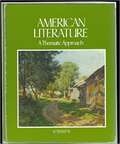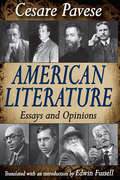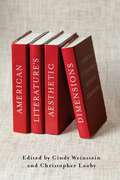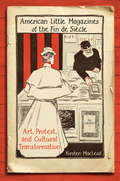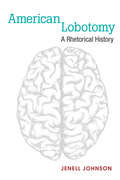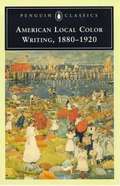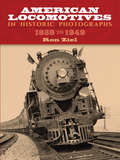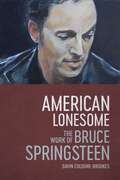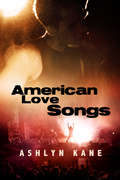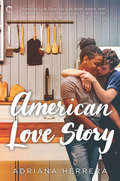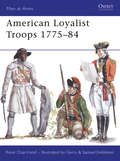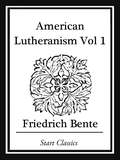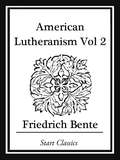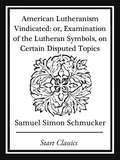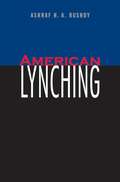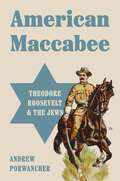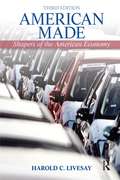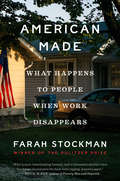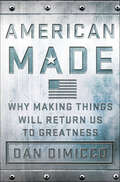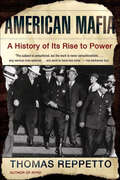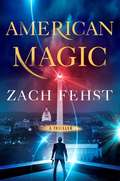- Table View
- List View
American Literature: A Thematic Approach
by G. Robert Carlsen Edgar H. Schuster Anthony TovattA thematically arranged anthology of poems, short stories, plays, novellas, and excerpts from longer works by American authors.
American Literature: Essays and Opinions
by Cesare Pavese Edwin FussellAn Italian author presents his views of American literature.
American Literature: Essays and Opinions (Princeton Legacy Library #1332)
by Cesare PaveseCesare Pavese (1908-1950) was the leading Italian scholar of American literature of the generation that came to maturity under Mussolini. He was not only an acute and wide-ranging literary critic, but also a sensitive poet and novelist. In addition, he was a prodigious translator. In collaboration with Elio Vittorini, he translated and brought to the attention of the Italian public the works of many important American writers. American literature helped to give direction to Pavese's creative work and was a resource for his personal literary campaign against Fascism.Pavese was a non-academic critic, though far less anti - academic than D. H. Lawrence. His first purpose was to use American literature to subvert Italian literature, but beyond that there were a number of issues on which he disagreed with standard American criticism. When he does, his wild, original energy of discovery can trigger a welcome change of focus for our views of American writing.Pavese never visited or lived in America; it was for him a foreign country, although a shifting and sliding special case. He had no stake in its sectional chauvinisms. He had a vital stake in its whole literature because, as his communications to Vittorini make clear, he had a stake in the literature of the whole world. For a while, America seemed to him the probable center of that whole. This was the center where things were happening in the world of the mind, and where the future was being born and licked into shape. Paveses's writings about American literature still offer original and unsparing insights.
American Literature’s Aesthetic Dimensions
by Cindy Weinstein Christopher. Eds. LoobyRethinking the category of aesthetics in light of recent developments in literary theory and social criticism, the contributors to this volume showcase the interpretive possibilities available to those who bring politics, culture, ideology, and conceptions of identity into their critiques. Essays combine close readings of individual works and authors with more theoretical discussions of aesthetic theory and its relation to American literature. In their introduction, Weinstein and Looby argue that aesthetics never left American literary critique. <P><P> Instead, the essay casts the current "return to aesthetics" as the natural consequence of shortcomings in deconstruction and new historicism, which led to a reconfiguration of aesthetics. Subsequent essays demonstrate the value and versatility of aesthetic considerations in literature, from eighteenth-century poetry to twentieth-century popular music. Organized into four groups—politics, form, gender, and theory—contributors revisit the canonical works of Henry James, Nathaniel Hawthorne, and Stephen Crane, introduce the overlooked texts of Constance Fenimore Woolson and Earl Lind, and unpack the complexities of the music of The Carpenters. Deeply rooted in an American context, these essays explore literature's aesthetic dimensions in connection to American liberty and the formation of political selfhood.Contributors include Edward Cahill, Ivy G. Wilson, June Ellison, Dorri Beam, Christopher Castiglia, Christopher Looby, Wendy Steiner, Cindy Weinstein, Trish Loughran, Jonathan Freedman, Elisa New, Dorothy Hale, Mary Esteve, Eric Lott, Sianne Ngai
American Little Magazines of the Fin de Siecle: Art, Protest, and Cultural Transformation (Studies in Book and Print Culture)
by Kirsten MacLeodIn American Little Magazines of the Fin de Siecle, Kirsten MacLeod examines the rise of a new print media form – the little magazine – and its relationship to the transformation of American cultural life at the turn of the twentieth century. Though the little magazine has long been regarded as the preserve of modernist avant-gardes and elite artistic coteries, for whom it served as a form of resistance to mass media, MacLeod’s detailed study of its origins paints a different picture. Combining cultural, textual, literary, and media studies criticism, MacLeod demonstrates how the little magazine was deeply connected to the artistic, social, political, and cultural interests of a rising professional-managerial class. She offers a richly contextualized analysis of the little magazine’s position in the broader media landscape: namely, its relationship to old and new media, including pre-industrial print forms, newspapers, mass-market magazines, fine press books, and posters. MacLeod’s study challenges conventional understandings of the little magazine as a genre and emphasizes the power of “little” media in a mass-market context.
American Lives and Legends
by John HoldrenThis book contains life stories of Young Benjamin Franklin, Phillis Wheatley, Paul Revere, Sybil Ludington, Sequoyah and stories of Washington Irving: Rip Van Winkle and The Legend of Sleepy Hollow.
American Lobotomy: A Rhetorical History
by Jenell JohnsonAmerican Lobotomy studies a wide variety of representations of lobotomy to offer a rhetorical history of one of the most infamous procedures in the history of medicine. The development of lobotomy in 1935 was heralded as a "miracle cure" that would empty the nation's perennially blighted asylums. However, only twenty years later, lobotomists initially praised for their "therapeutic courage" were condemned for their barbarity, an image that has only soured in subsequent decades. Johnson employs previously abandoned texts like science fiction, horror film, political polemics, and conspiracy theory to show how lobotomy's entanglement with social and political narratives contributed to a powerful image of the operation that persists to this day. The book provocatively challenges the history of medicine, arguing that rhetorical history is crucial to understanding medical history. It offers a case study of how medicine accumulates meaning as it circulates in public culture and argues for the need to understand biomedicine as a culturally situated practice.
American Local Color Writing, 1880-1920
by Elizabeth Ammons Valerie Rohy<p>The era in the United States between the Civil War and the end of World War I, was marked by increased nation-building, immigration, internal migration and racial tension. This period of time saw the rise of local colour literature, which described the peculiarities of regional life through "lived experiences." This anthology brings together works from every part of America, written by men and women of many cultures, ethnicities, ideologies and literary styles. The book features such familiar writers as Joel Chandler Harris, Kate Chopin, Hamlin Garland and Sarah Orne Jewett, and introduces less well-known voices like Sui Sin Far, Abraham Cahan and Zitkala-Sa. The writings illuminate varying concepts of the American identity and racial, class and ethnic stereotypes are both introduced and challenged in many of of the stories. <p>For more than seventy years, Penguin has been the leading publisher of classic literature in the English-speaking world. With more than 1,700 titles, Penguin Classics represents a global bookshelf of the best works throughout history and across genres and disciplines. Readers trust the series to provide authoritative texts enhanced by introductions and notes by distinguished scholars and contemporary authors, as well as up-to-date translations by award-winning translators.</p>
American Locomotives in Historic Photographs: 1858 to 1949
by Ron ZielThis rare collection of 126 "builder portraits" of American locomotives offers an exciting cavalcade of images that chronicle the momentous rise of steam locomotive power in America. Builder portraits are especially prized by railway historians because they are the exacting official photographs of new models taken before repairs, alterations, and weathering altered their original appearance. The builder portraits reprinted here were selected from the William A. Rogers collection, a priceless archive of images documenting the history of American steam locomotion from the pre-Civil War era to the mid-20th century. While the accent in this book is on the oldest and rarest photographs in the Rogers collection, many modern portraits are included as well to demonstrate how highly developed the American steam locomotive had become before the advent of dieselization. Among the engines depicted are the España, a diminutive model built for the Spanish government in 1858; engine no. 216 of the Pennsylvania Railroad, a "fearsome apparition of Gothic character" built in 1861; the Chimbote Emilia, an inspection engine built for railroad company officials in 1868 that is considered a masterpiece of the engine builder's art; and a Union Pacific 1940s' "Big Boy," the largest and heaviest type of steam locomotive ever built.Clearly, builder portraits are the most revealing record possible of the evolution of the American steam locomotive. This rich selection offers railroading historians and enthusiasts a peerless record of a great age in railway history. Railroading expert Ron Zeil's introduction and captions provide readers with a brief railroading background, a commentary on the art of the builder portrait and key details on each locomotive depicted.
American Lonesome: The Work of Bruce Springsteen
by Gavin Cologne-BrookesAmerican Lonesome: The Work of Bruce Springsteen begins with a visit to the Jersey Shore and ends with a meditation on the international legacy of Springsteen’s writing, music, and performances. Gavin Cologne-Brookes’s innovative study of this popular musician and his position in American culture blends scholarship with personal reflection, providing both an academic examination of Springsteen’s work and a moving account of how it offers a way out of emotional solitude and the potential lonesomeness of modern life. <P><P>Cologne-Brookes proposes that the American philosophical tradition of pragmatism, which assesses the value of ideas and arguments based on their practical applications, provides a lens for understanding the diversity of perspectives and emotions encountered in Springsteen’s songs and performances. Drawing on pragmatist philosophy from William James to Richard Rorty, Cologne-Brookes examines Springsteen’s formative environment and outsider psychology, arguing that the artist’s confessed tendency toward a self-reliant isolation creates a tension in his work between lonesomeness and community. He considers Springsteen’s portrayals of solitude in relation to classic and contemporary American writers, from Frederick Douglass, Nathaniel Hawthorne, and Emily Dickinson to Richard Wright, Flannery O’Connor, and Joyce Carol Oates. As part of this critique, he discusses the difference between escapist and pragmatic romanticism, the notion of multiple selves as played out both in Springsteen’s work and in our perception of him, and the impact of performances both recorded and live. By drawing on his own experiences seeing Springsteen perform—including on tours showcasing the album The River in 1981 and 2016—Cologne-Brookes creates a book about the intimate relationship between art and everyday life. <P><P>Blending research, cultural knowledge, and creative thinking, American Lonesome dissolves any imagined barriers between the study of a songwriter, literary criticism, and personal testimony.
American Love Songs
by Ashlyn KaneJake Brenner has too many wild oats to sow to fall in love--or so he claims. Besides, he's much too busy with his band, the Wayward Sons, to go looking for romance. His reticence has nothing to do with his embarrassing crush on Chris, the band's lead singer and Jake's erstwhile best friend. But that was before enigmatic wanderer Parker McAvoy signed on as the band's new lead guitarist. He can only deny his attraction to sweet, dorky Parker for so long before the urge to do something about it becomes impossible to ignore. The trouble is, Parker knows all about Jake's philandering ways--and oh, yeah, he's not gay. Or so Jake thinks until a string of related events provides encouraging new insight. Can he convince Parker to overlook his colorful past and give him a chance? Or will this love song fade out before it even begins?
American Love Story: A Multicultural Romance (Dreamers #3)
by Adriana HerreraNo one should have to choose between love and justice.Haitian-born professor and activist Patrice Denis is not here for anything that will veer him off the path he’s worked so hard for. One particularly dangerous distraction: Easton Archer, the assistant district attorney who last summer gave Patrice some of the most intense nights of his life, and still makes him all but forget they’re from two completely different worlds. All-around golden boy Easton forged his own path to success, choosing public service over the comforts of his family’s wealth. With local law enforcement unfairly targeting young men of color, and his career—and conscience—on the line, now is hardly the time to be thirsting after Patrice again. Even if their nights together have turned into so much more. For the first time, Patrice is tempted to open up and embrace the happiness he’s always denied himself. But as tensions between the community and the sheriff’s office grow by the day, Easton’s personal and professional lives collide. And when the issue at hand hits closer to home than either could imagine, they’ll have to work to forge a path forward…together. One-click with confidence. This title is part of the Carina Press Romance Promise: all the romance you’re looking for with an HEA/HFN. It’s a promise!This book is approximately 95,000 words
American Loyalist Troops 1775-84
by Gerry Embleton Rene ChartrandTo celebrate the 450th title in the Men-at-Arms series, this book examines in depth the units and the uniforms of a still-controversial army: the many thousands of American colonists who chose to fight for King George during the Revolution. In addition to the better-known corps from the Atlantic seaboard, the author also covers the units raised for service against the Spanish in the Floridas, the Caribbean islands and Central America. The text is illustrated with portraits, photographs of rare surviving artifacts, and features color reconstructions by Gerry Embleton, the respected expert on 18th century American forces whose work was recently exhibited in the Smithsonian Institute.
American Lutheranism
by Friedrich Bente"American Lutheranism Vol 1" is a religious text written by Friedrich Bente.
American Lutheranism
by Friedrich Bente"American Lutheranism Vol 2" is a religious text written by Friedrich Bente.
American Lutheranism Vindicated: or, Examination of the Lutheran Symbols, on Certain Disputed Topics
by Samuel Simon Schmucker"American Lutheranism Vindicated: or, Examination of the Lutheran Symbols, on Certain Disputed Topics" is a religious text written by Samuel Simon Schmucker.
American Lynching
by Ashraf H. RushdyA history of lynching in America over the course of three centuries, from colonial Virginia to twentieth-century Texas.After observing the varying reactions to the 1998 death of James Byrd Jr. in Texas, called a lynching by some, denied by others, Ashraf Rushdy determined that to comprehend this event he needed to understand the long history of lynching in the United States. In this meticulously researched and accessibly written interpretive history, Rushdy shows how lynching in America has endured, evolved, and changed in meaning over the course of three centuries, from its origins in early Virginia to the present day.&“A work of uncommon breadth, written with equally uncommon concision. Excellent.&” —N. D. B. Connolly, Johns Hopkins University&“Provocative but careful, opinionated but persuasive . . . Beyond synthesizing current scholarship, he offers a cogent discussion of the evolving definition of lynching, the place of lynchers in civil society, and the slow-in-coming end of lynching. This book should be the point of entry for anyone interested in the tragic and sordid history of American lynching.&” —W. Fitzhugh Brundage, author of Lynching in the New South: Georgia and Virginia, 1880-1930&“A sophisticated and thought-provoking examination of the historical relationship between the American culture of lynching and the nation&’s political traditions. This engaging and wide-ranging meditation on the connection between democracy, lynching, freedom, and slavery will be of interest to those in and outside of the academy.&” —William Carrigan, Rowan University&“In this sobering account, Rushdy makes clear that the cultural values that authorize racial violence are woven into the very essence of what it means to be American. This book helps us make sense of our past as well as our present.&” —Jonathan Holloway, Yale University
American Maccabee: Theodore Roosevelt and the Jews
by Andrew PorwancherA major biography of a mesmerizing statesman whose complex bond with the Jewish people forever shaped their lives—and his legacyA scion of the Protestant elite, Theodore Roosevelt was an unlikely ally of the waves of impoverished Jewish newcomers who crowded the docks at Ellis Island. Yet from his earliest years he forged ties with Jews never before witnessed in a president. American Maccabee traces Roosevelt&’s deep connection with the Jewish people at every step of his dazzling ascent. But it also reveals a man of contradictions whose checkered approach to Jewish issues was no less conflicted than the nation he led.As a rising political figure in New York, Roosevelt barnstormed the Lower East Side, giving speeches to packed halls of Jewish immigrants. He rallied for reform of the sweatshops where Jewish laborers toiled for pitiful wages in perilous conditions. And Roosevelt repeatedly venerated the heroism of the Maccabee warriors, upholding those storied rebels as a model for the American Jewish community. Yet little could have prepared him for the blood-soaked persecution of Eastern European Jews that brought a deluge of refugees to American shores during his presidency. Andrew Porwancher uncovers the vexing challenges for Roosevelt as he confronted Jewish suffering abroad and antisemitic xenophobia at home.Drawing on new archival research to paint a richly nuanced portrait of an iconic figure, American Maccabee chronicles the complicated relationship between the leader of a youthful nation and the people of an ancient faith.
American Machiavelli
by John Lamberton HarperAlexander Hamilton (1757-1804) was an illegitimate West Indian emigrant who became the first U. S. Secretary of the Treasury. American Machiavelli focuses on Hamilton's controversial activities as foreign policy adviser and aspiring military leader. In the first major study of his foreign policy role in 30 years, John Lamberton Harper describes a decade of bitter division over the role of the Federal government in the economy during the 1790s and draws parallels between Hamilton and the sixteenth century Italian political adviser, Niccolò Machiavelli. Harper provides an original and highly readable account of Hamiltonas famous clashes with Thomas Jefferson and John Adams, and his key role in defining the U. S. national security strategy. John Lamberton Harper is Professor of Foreign Policy and European Studies at the Johns Hopkins University Bologna Center. He is the author of America and the Reconstruction of Italy, 1945-1948 (Cambridge 1986), winner of the 1987 Marraro Prize from the Society for Italian Historical Studies, and American Visions of Europe: Franklin D. Roosevelt, George F. Kennan, and Dean G. Asheson (Cambridge 1994), winner of the 1995 Robert Ferrell Prize from the Society of Historians of American Foreign Relations. His articles and reviews have appeared in numerous publications, including The American Historical Review, The Journal of American History, The Times Literary Supplement and Foreign Affairs.
American Made: Shaping the American Economy
by Harold C LivesayAmerican Made is a best-selling collection of biographical sketches that introduces key trends of American business.The book details American business through time by presenting the history of people who forever changed the way that Americans do business. Harold Livesay maintains clarity and intellectual acumen while highlighting two themes: globalization and the impact of information technology on business. This edition includes updated stories of its hallmark historical business figures with the latest scholarship as well as additional biographies of figures that have redefined American business in recent years.
American Made: What Happens to People When Work Disappears
by Farah StockmanWhat happens when Americans lose their jobs? In this illuminating story of ruin and reinvention, Pulitzer Prize-winning journalist Farah Stockman gives an up-close look at the profound role work plays in our sense of identity and belonging, as she follows three workers whose lives unravel when the factory they have dedicated so much to closes down. &“With humor, breathtaking honesty, and a historian&’s satellite view, Stockman illuminates the fault lines ripping America apart.&”—Beth Macy, author of Factory Man and DopesickShannon, Wally, and John built their lives around their place of work. Shannon, a white single mother, became the first woman to run the dangerous furnaces at the Rexnord manufacturing plant in Indianapolis, Indiana, and was proud of producing one of the world&’s top brands of steel bearings. Wally, a black man known for his initiative and kindness, was promoted to chairman of efficiency, one of the most coveted posts on the factory floor, and dreamed of starting his own barbecue business one day. John, a white machine operator, came from a multigenerational union family and clashed with a work environment that was increasingly hostile to organized labor.The Rexnord factory had served as one of the economic engines for the surrounding community. When it closed, hundreds of people lost their jobs. What had life been like for Shannon, Wally, and John, before the plant shut down? And what became of them after the jobs moved to Mexico and Texas? American Made is the story of a community struggling to reinvent itself. It is also a story about race, class, and American values, and how jobs serve as a bedrock of people&’s lives and drive powerful social justice movements. This revealing book shines a light on a crucial political moment, when joblessness and anxiety about the future of work have made themselves heard at a national level. Most of all, it is a story about people: who we consider to be one of us and how the dignity of work lies at the heart of who we are.
American Made: Why Making Things Will Return Us to Greatness
by Dan DiMiccoAmerican manufacturing is on life support—at least, that's what most people think. The exodus of jobs to China and other foreign markets is irreversible, and anything that is built here requires specialized skills the average worker couldn't hope to gain. Not so, says Dan DiMicco, chairman and former CEO of Nucor, America's largest steel company. He not only revived a major US manufacturing firm during a recession, but helped galvanize the flagging domestic steel industry when many of his competitors were in bankruptcy or headed overseas. In American Made, he takes to task the politicians, academics, and political pundits who, he contends, are exacerbating fears and avoiding simple solutions for the sake of nothing more than their own careers, and contrasts them with the postwar leaders who rebuilt Europe and Japan, put a man on the moon, and kept communism at bay. We need leaders of such resolve today, he argues, who can tackle a broken job-creation engine by restoring manufacturing to its central role in the U.S. economy—and cease creating fictitious "service businesses" where jobs evaporate after a year or two, as in a Ponzi scheme. With his trademark bluntness, DiMicco tackles the false promise of green jobs and the hidden costs of outsourcing. Along the way, he shares the lessons he's learned about good leadership, crisis management, and the true meaning of innovation, and maps the road back to robust economic growth, middle-class prosperity, and American competitiveness.
American Mafia: A History of Its Rise to Power
by Thomas Reppetto"Reppetto's book earns its place among the best . . . he brings fresh context to a familiar story worth retelling." —The New York Times Book Review Organized crime—the Italian American kind—has long been a source of popular entertainment and legend. Now Thomas Reppetto provides a balanced history of the Mafia's rise—from the 1880s to the post-WWII era—that is as exciting and readable as it is authoritative.Structuring his narrative around a series of case histories featuring such infamous characters as Lucky Luciano and Al Capone, Reppetto draws on a lifetime of field experience and access to unseen documents to show us a locally grown Mafia. It wasn't until the 1920s, thanks to Prohibition, that the Mafia assumed what we now consider its defining characteristics, especially its octopuslike tendency to infiltrate industry and government. At mid-century the Kefauver Commission declared the Mafia synonymous with Union Siciliana; in the 1960s the FBI finally admitted the Mafia's existence under the name La Cosa Nostra.American Mafia is a fascinating look at America's most compelling criminal subculture from an author who is intimately acquainted with both sides of the street.
American Magic: A Thriller
by Zach FehstIn this fast-paced, international thriller, chaos erupts after a shadowy figure with ties to an elite and ancient society posts incantations on the dark web that allow people to perform real magic.When an enigmatic message uploaded to the dark web turns out to contain an ancient secret giving regular people the power to do impossible things, like levitate cars or make themselves invisible, American government officials panic. They know the demo videos on YouTube and instructions for incantations could turn from fantastical amusement to dangerous weapon at the drop of the hat, and they scramble to keep the information out of the wrong hands. They tap Ben Zolstra, an ex-CIA field operative whose history with the Agency is conflicted at best, to lead the team that’s racing to contain the dangerous knowledge—and track down the mysterious figure behind the leak who threatens that even more dangerous spells will be released one by one until the world as we know it no longer exists. This sweeping, globe-spanning thriller explores the dark consequences of a question mankind has been asking for centuries: What if magic were real?
American Magnitude: Hemispheric Vision and Public Feeling in the United States
by Christa J. OlsonAt a moment in US politics when racially motivated nationalism, shifting relations with Latin America, and anxiety over national futures intertwine, understanding the long history of American preoccupation with magnitude and how it underpins national identity is vitally important. In American Magnitude, Christa J. Olson tracks the visual history of US appeals to grandeur, import, and consequence (megethos), focusing on images that use the wider Americas to establish US character. Her sources—including lithographs from the US-Mexican War, pre–Civil War paintings of the Andes, photo essays of Machu Picchu, and WWII-era films promoting hemispheric unity—span from 1845 to 1950 but resonate into the present. <p><p>Olson demonstrates how those crafting the appeals that feed the US national imaginary—artists, scientists, journalists, diplomats, and others—have invited US audiences to view Latin America as a foil for the greatness of their own nation and encouraged white US publics in particular to see themselves as especially American among Americans. She reveals how each instance of visual rhetoric relies upon the eyes of others to instantiate its magnitude—and falters as some viewers look askance instead. The result is the possibility of a post-magnitude United States: neither great nor failed, but modest, partial, and imperfect.
